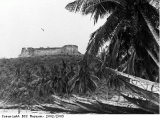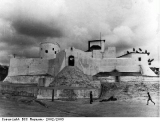Resisting slavery
Enslaved Africans resisted, or rebelled, against their position as slaves in many different ways. Each expression of resistance by enslaved individuals or groups counted as acts of rebellion against the system of slavery. The many instances of resistance show that slaves were not passive victims of slavery. Instead they proved their strength and determination in fighting for their freedom. In particular, enslaved Africans on the Caribbean plantations rebelled against their owners in many different ways.
Link to: This can be read about further in Black Resistance.
The transatlantic slave trade imposed by the Europeans must have been terrifying. African traders took people from their villages and families in West Africa. From this moment, the captured men, women and children fought and found ways to rebel against their captors. Some people would manage to escape before being taken to the coast where they were to be sold to the Europeans. Some would commit suicide so that they could not be enslaved.
Some of the enslaved Africans were sold by individual traders along the coast. The European ships sailed around the west coast of Africa, stopping at trading ports. Small boats would go between the ship and the land, carrying negotiators to make deals, trade goods and slaves. In this way a ship’s captain could slowly fill his ship, taking several months to move around the coast. This detail from the leaflet published by the Plymouth Committee for the Abolition of the Slave Trade, shows slaves in the hold of the Liverpool slave ship the Brookes, in 1788. The male slaves were kept in chains to prevent rebellion. The enslaved Africans could be kept like this for up to eight months while the slave ship moved up and down the coast of West Africa. This was in addition to the journey across the Atlantic Ocean itself, which took a further six to eight weeks, but bad weather could increase this to 13 weeks or more.
Another way of buying slaves was from the slave forts run by the European trading companies. The Europeans built large forts up and down the coast of West Africa. Some of the enslaved Africans were taken to the forts and kept there. They were then loaded onto the ships for the next phase of the journey across the Atlantic Ocean to the Caribbean. The forts would have been difficult for people to escape from. They were built with this in mind. The enslaved Africans held in the forts would be from different areas and cultural, or ethnic, groups. The different groups would speak different languages, which meant that communication and plotting between the enslaved would be less likely. Pictured here are photographs of two trading forts, Fort St. Sebastian and Dixcove trading fort, both in Ghana, West Africa. The photographs were taken in the 1950s and show what remained of the 18th century forts.
The enslaved Africans might have to wait for several months in the forts or in the ships before being taken across the Atlantic to the plantations in the Caribbean. The conditions in the forts and ships would gradually become more unbearable as time went on. The next part of the journey aboard the European ships is told in The Atlantic Crossing.




